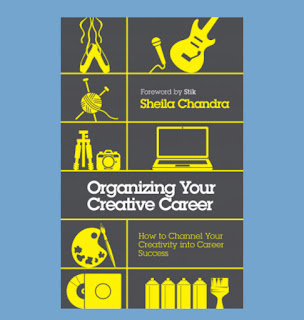Book Review: Organizing Your Creative Career by Sheila Chandra
When our alumni get asked what the most important skill they learned in graduate school was, nearly all will say, "Time management!" And yet, recently a student asked to recommend a book which would teach this skill for creative professionals, and I had no go-to title.
I realized my own unconscious bias--that time management was something one learns from doing, from observing what works for others in the industry, and that one cobbles together a selection of tricks and techniques in a personalized way. Then, along came this book and here we have it: a road map, explanations, documentation of techniques.
Chandra has some excellent advice on streamlining creative productivity. I particularly appreciated the section discussing why you should outsource elements of the work that you can, such as, say, hiring someone to prime your canvases or buying pre-primed where you can, to conserve your energies for the artistic work of painting. I constantly reinforce this with my graduate students in terms of planning workflow: if you can delegate it, do so and focus your expertise on the tasks no one but you can take care of. I particularly appreciate the way the author addresses the stereotype of the Chaotic Genius. This stereotype is alive and well, even among people who decide to pursue graduate study in their artistic disciplines.
Chandra also includes some pearls of wisdom such as "don't hire your friends/family" and "the Pomodoro method really does result in work/rest balance", and goes on to explain why. She also has some great tips on accounting, networking, and streamlining the more "boring" parts of being a success in a creative field.
One thing that struck me as odd about this book is the life-organization/scheduling/admin section. It was written as if smartphones don't exist. Chandra offers lots of solid advice about tracking different types of tasks and responsibilities, but she's developed a system that is entirely paper-based for which one must adopt the use of a ruled notebook, a diary, Post-It notes, a physical calendar, and a three-tray file for paperwork sorting. It struck me as a bit archaic and perhaps even difficult to apply to a digitally-connected artist. I got some tips from this section, but most are applicable to how I use extant apps on my iPhone. It's strange, because throughout the section on organizing your creative process, she DOES talk about digital organizational tools you can use (folders of bookmarks, templates you find online, etc). I dunno. It doesn't make the advice itself obsolete, but I mentally substituted useful apps for the physical-world techniques throughout that whole bit.
Basically, this book is what I will recommend in future to students who ask for resources on how to manage their time, how to increase productivity, and how to not just survive as a working artist but actually succeed (and still have time/energy for other things, like a family life or athletic pursuits or whatever).
I received an advance readers' copy of this book from NetGalley in exchange for an honest review.



Comments
Post a Comment